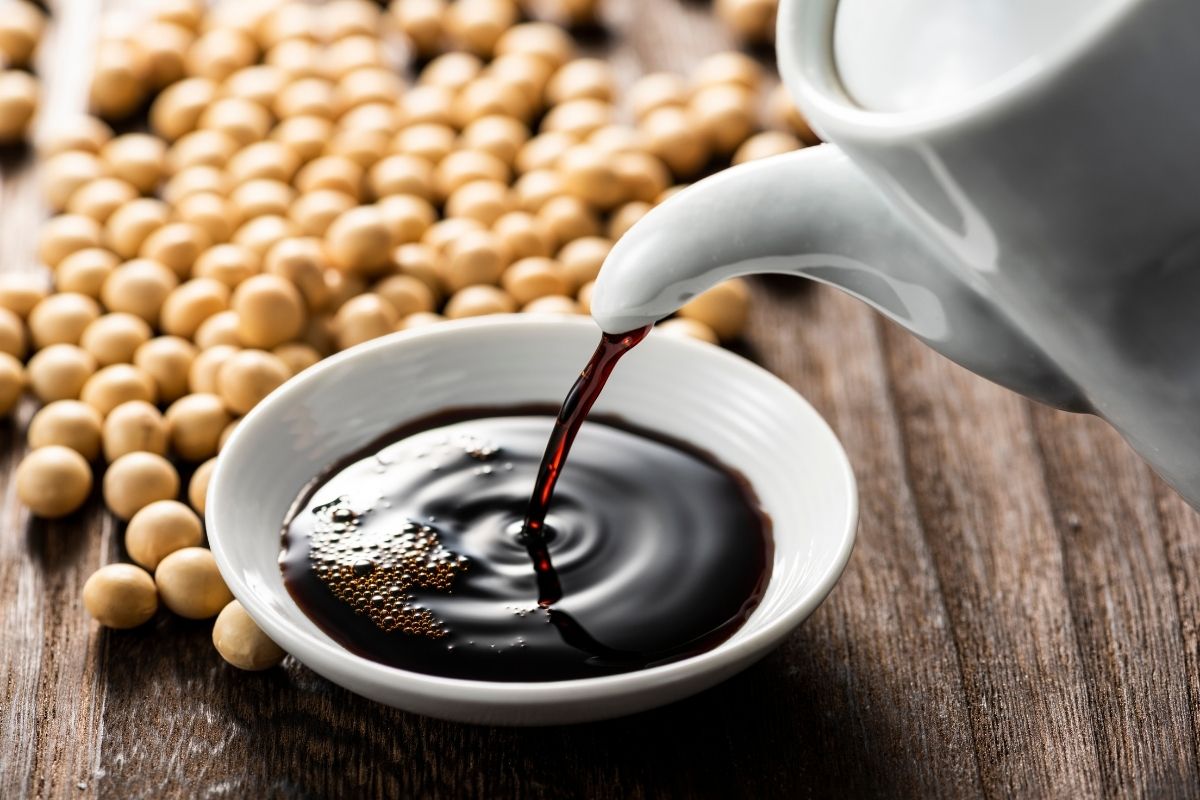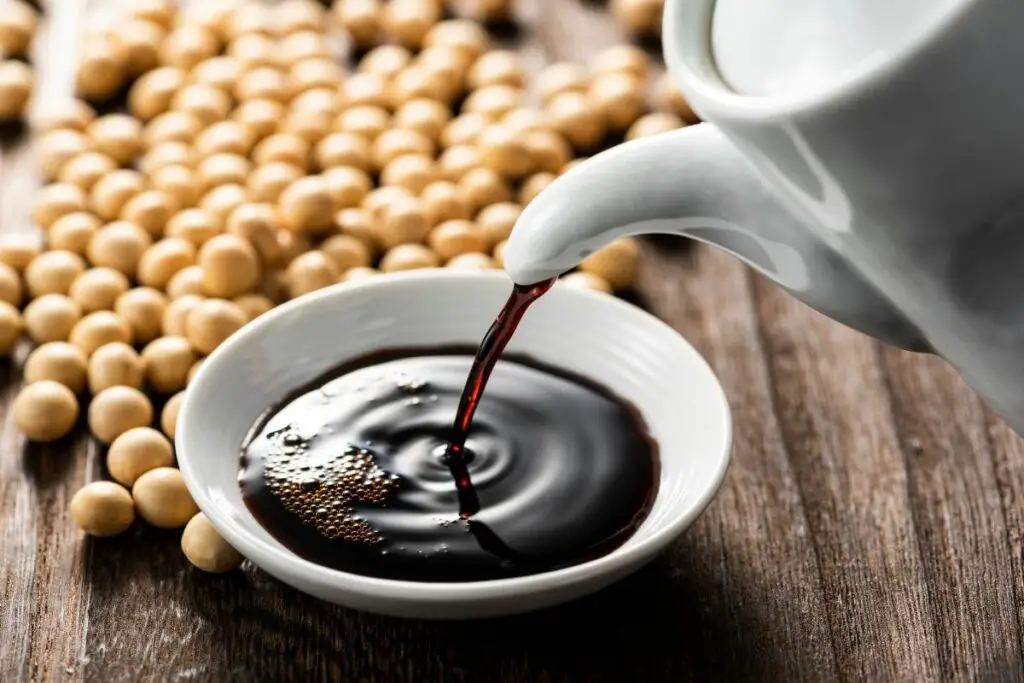If you have recently begun your Japanese cooking and are puzzled at the mention of shoyu, then you need not worry anymore because this article will tell you all about it!
What Is Shoyu?

Shoyu is a generic name for Japanese-style soy sauces produced from fermented soybeans, salt, wheat, and water.
They are often thin and transparent and make an excellent all-purpose cooking and table sauce.
Soy sauce, a thin, amber liquid used with stir-fries, sushi, and dipping sauces, and originated centuries ago in China.
There, the sauce was typically made entirely of soy, with no additional components. The fermenting process is responsible for the sauce’s rich taste and pronounced saltiness.
Enzymes from the mold operate on the soy and wheat proteins during fermentation, gradually breaking them down into amino acids.
The starches are broken down into simple sugars, which are subsequently fermented to produce alcohol and lactic acid.
Natural fermentation is used only in high-quality soy sauce. These types are frequently branded “naturally brewed”. Water, wheat, soy, and salt are the most common components.
When soy sauce was established in Japan, the formula was altered to include equal parts soybeans and wheat.
Brewing the beans with wheat lends a subtle sweetness to the flavor, making it less harsh and more rounded. Shoyu is the Japanese term for soy sauce.
Shoyu has a cult following of die-hard enthusiasts who prefer the full-bodied taste and subtle sweetness over aggressive Chinese soy sauce.
However, not all shoyus are created equal, so it’s a good idea to do your research before heading to the store.
What Does Shoyu Taste Like?
Shoyu is a flavorful sauce with a complex taste profile. According to Kikkoman, there are over 300 distinct taste profiles, including some traces of vanilla, fruit, whisky, and espresso.
While it is difficult to specify a certain flavor, there are so many that it doesn’t really matter.
Regular soy sauce is made entirely of soybeans; nothing else is added. As previously said, shoyu contains equal soybean and wheat in the sauce, which means the flavor will be slightly different.
While traditional soy sauce is saltier and heavier in flavor, shoyu has a sweeter taste and a more delicate flavor.
Shoyu Varieties
Koikuchi
This popular kind, known as “dark” shoyu, is rich and strong. Even if they aren’t labeled as such, shoyu bottles in most U.S. grocery shops are of the koikuchi kind.
It may be used to make marinades, dips, basting sauces, stir-fries, and other dishes.
Usukuchi
This “light” shoyu has a more salty, strong taste. However, mirin, a sweet rice wine, is added at the conclusion of the fermenting process, making usukuchi shoyu sweeter than koikuchi but not the sweetest shoyu choice.
Shiro
This lighter shoyu variety is ideal for adding shoyu flavor without turning your ingredients or final dish a dark color.
Because it has a larger amount of wheat, this shoyu is also sweeter than the others. It’s very good at steaming soups, hot pots, and steamed veggies.
Tamari
Tamari has little to no wheat, making it a perfect gluten-free condiment alternative. Tamari is thicker, richer, and nearly sweeter.
It’s great for dipping and may be found in salads, stir-fries, and poured over light foods like fish and chicken.
Sai Shikomi
This variety of shoyu is unlikely to be found in conventional grocery shops, although it may be available at your local Asian market.
Because this sweet sauce is doubly fermented, it takes longer to make than other types.
Cooking With Shoyu

Shoyu, like soy sauce, is excellent as a dipping sauce. There are several dip alternatives, including meats, steamed veggies, sushi, and others.
However, dishes such as ramen and the wildly famous shoyu chicken are all about adding soy sauce to the dish.
Shoyu, for example, is a key component in ramen. According to Bon Appétit, add it to the tare, which is subsequently added to the dashi, a Japanese stock.
Allow the dashi to rest at room temperature for eight to 12 hours. After that, add the shoyu and mirin to make the tare.
This will be the delicious ramen soup that goes with the pork, cooked egg, and noodles garnish.
Is Shoyu Healthy?
While shoyu may appear to be a simple, light sauce, it is not the healthiest thing in the world.
Soy sauce should be avoided at all costs if you are sensitive to gluten, soy, or wheat, according to Health.
It may not appear to be much due to its low-calorie count, but there are several things to be aware of.
According to Healthline, one tablespoon of conventionally fermented soy sauce has eight calories, one gram of carbs, zero grams of fat, one gram of protein, and a whopping 902 milligrams of sodium.
One person should only drink approximately 1,500 mg of sodium per day; thus soy sauce isn’t ideal for individuals wanting to limit their salt consumption.
However, because of the fermented process, there is some evidence that it may aid by introducing healthy bacteria to your digestive tract.
It has also been connected to aiding allergy sufferers – who knew? Overall, even a modest amount of soy sauce will add a significant amount of salt and sodium to your diet, so don’t eat it on a regular basis.
Summary
Soy sauce is a delicious condiment that may be found in a broad range of meals and cuisines. It is prepared entirely from fermented soybeans.
Soy sauce can be light in color and texture, or inky black, depending on how they are handled and how long they are fermented.
Different soy sauces are created to complement specific cuisines; in Japan, two popular varieties are tamari shoyu, which is prepared by pressing the soybeans used to make saishikomi, and miso, a double-brewed shoyu that is exceedingly strong.
It can be created naturally or by chemical hydrolysis. Each technique of cultivation results in a distinct flavor and health profile.
Consuming soy sauce may provide certain health hazards. The worst of them, however, are connected with chemically made versions, which may be avoided by buying organically fermented soy sauce.
Overall, soy sauce, like other foods, can be consumed in moderation as part of a balanced diet.









